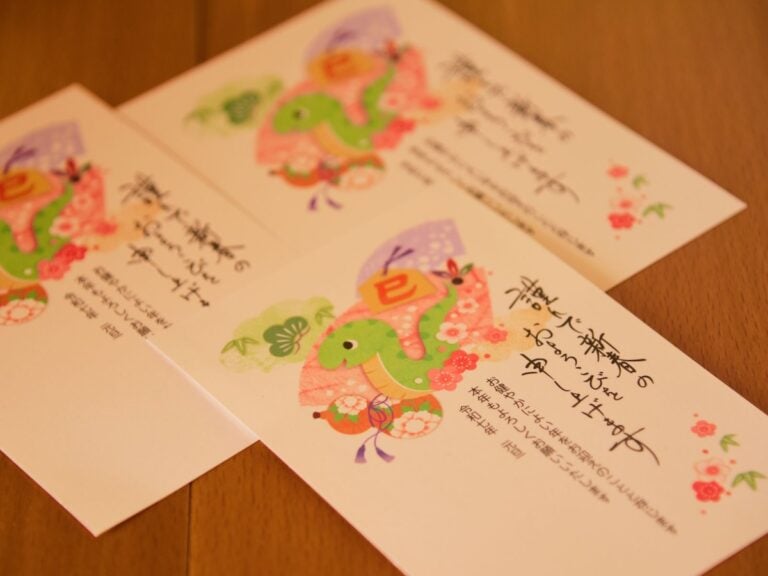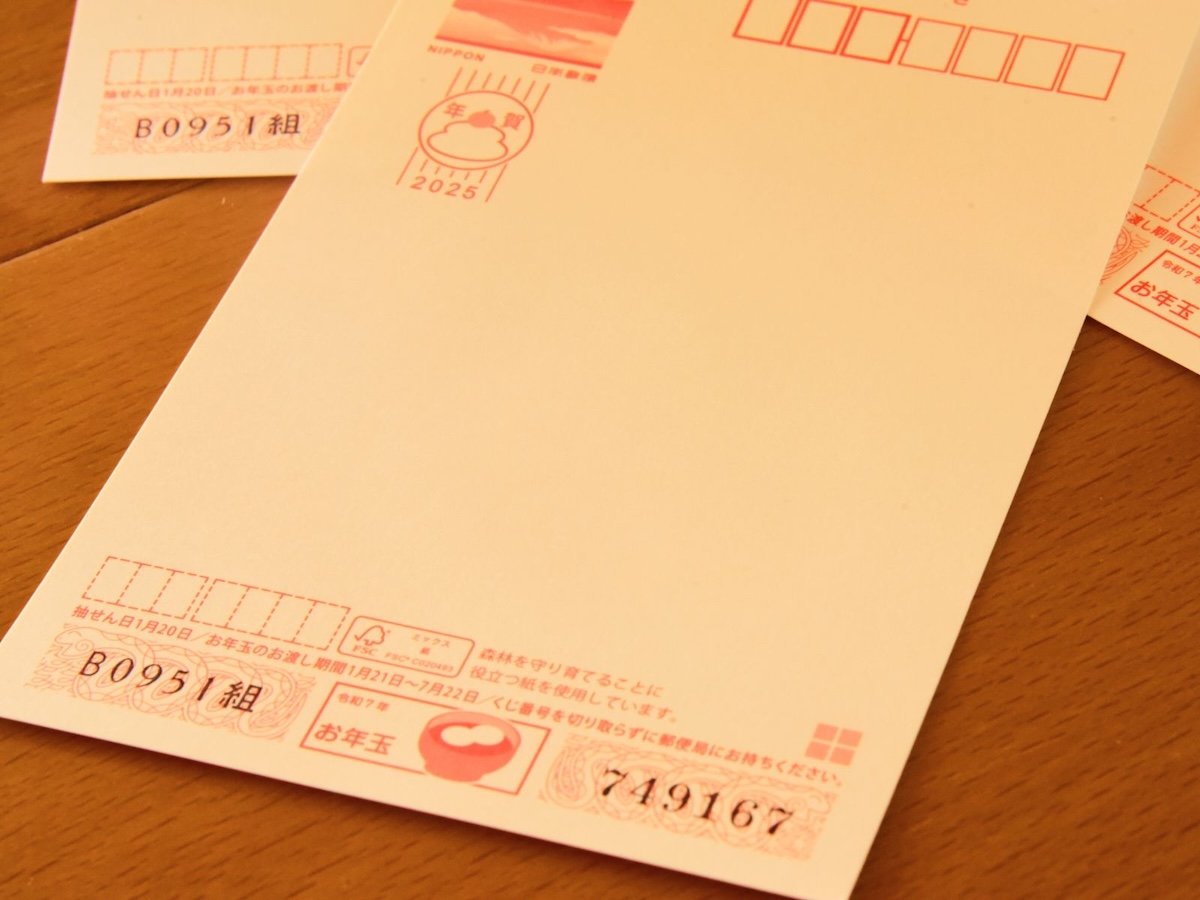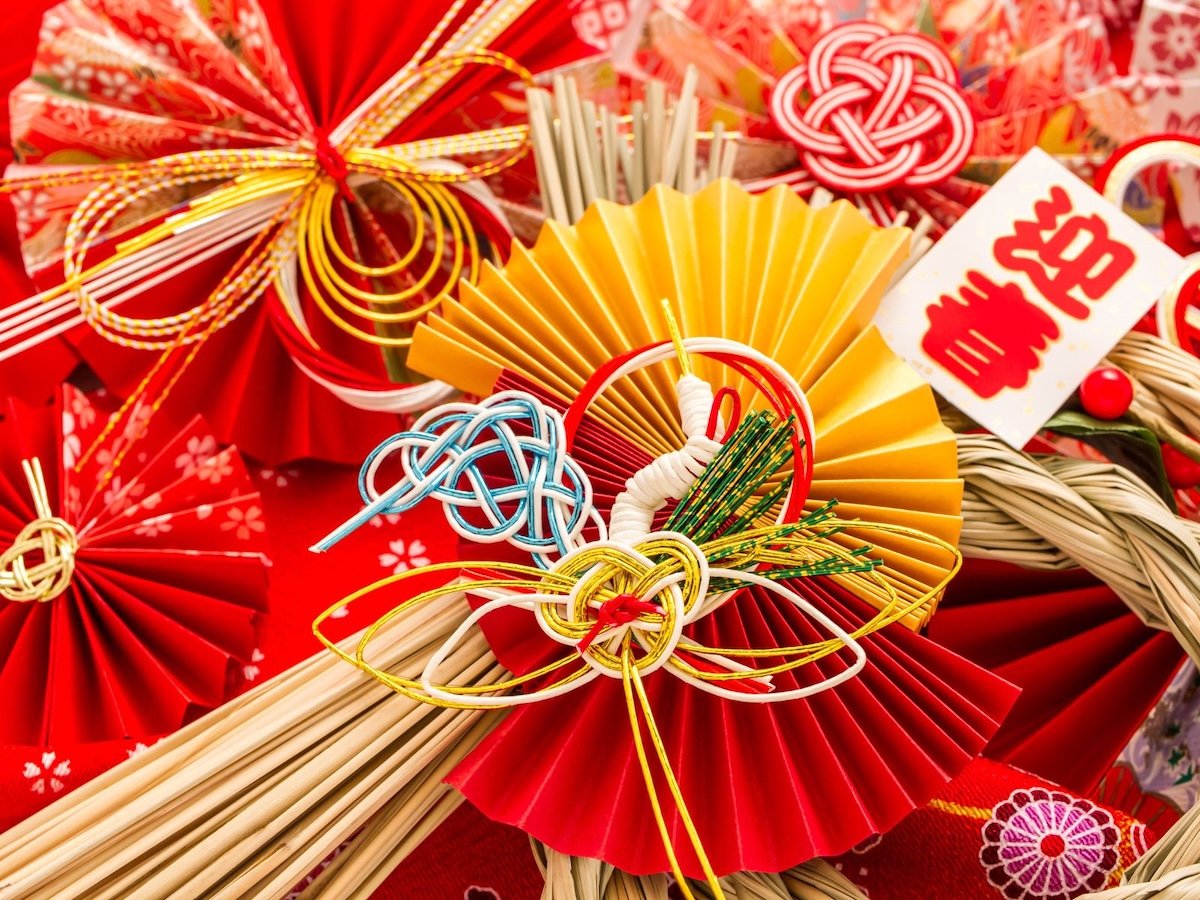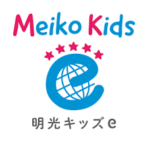
Nengajo, Japan’s New Year’s greeting card, is written in Kanji as 年賀状. 年 means year、賀 means joy and celebration andv状 refers to a letter. New Year’s greetings are traditionally written on postcards and hold a special place in Japan’s New Year traditions.
As New Year’s is considered an auspicious holiday, sending nengajo is a way to express gratitude to friends, family, and business associates for their support over the past year or simply to maintain connections. Businesses, in particular, use nengajo to stay connected with their customers. If you submit your cards by the designated deadline in mid-December, typically around the 15th, Japan Post ensures they are delivered precisely on New Year’s Day, January 1st.
Ideally, your nengajo should be sent and received before January 3rd, which as a rule marks the end of the New Year holiday period. As you review the cards you received on the morning of January 1st, you may notice someone you missed. Fortunately, there is still time to mail a card and aim for it to reach them by the 3rd, keeping the New Year spirit alive.
One unique feature of nengajo, setting them apart from Christmas cards popular in many Western countries, is the lottery and prizes associated with New Year’s postcards issued by Japan Post. The postcards made by Japan Post include a lottery number printed on the bottom of the address side, offering recipients the chance to win prizes ranging from cash to regional specialty goods. This added element of excitement makes receiving nengajo a special tradition that many look forward to each year.
Another important rule of nengajo is to avoid sending them to someone who has recently lost a family member, out of respect for the grieving family. In such cases, families in mourning typically refrain from sending traditional nengajo. Instead, they send a mochū hagaki (mourning postcard), which notifies others that they will not be sending nengajo for the upcoming year, acknowledging their loss and observing the period of mourning.
Another guideline for nengajo is that no punctuation should be used in writing. For example, あけましておめでとうございます(happy new year) should be written as one phrase without punctuation. Moreover, you should not use ending punctuation; every sentence can just be written on a separate line. The reason is that if you put a period at the end, it is like you are ending your contact with this person. Starting a new year is about looking toward the future, so if you put a period, it is considered rude. This is a historical custom and younger people may use punctuation now, so don’t panic if you forget.

The Decline of Nengajo
Japan’s postal service began issuing New Year’s postcards in 1949, shortly after the war, with an initial offering of about 180 million cards. As the nation experienced economic recovery and population growth, the tradition gained immense popularity, with print numbers reaching one billion by 1964 and surpassing two billion by 1973.
However, by 2024, reflecting changes such as a declining population and shifting communication trends, Japan Post announced a significant cut in production. The number of printed cards will be reduced to just over one billion—a 25% drop from the previous year, marking the largest year-on-year decrease in history.
The peak of postcard popularity came in 2003, when an average of 35 New Year’s cards were sent per person. Since then, the number has steadily declined, hitting a record low of just sixteen cards per person in 2021. This downward trend underscores the evolving way people connect and celebrate.
One of the early innovations that helped sustain the tradition of nengajo was the compact, self-contained postcard printing system developed in 1977 by the Riso Kagaku Corporation. Known as Print Gocco, this device gained immense popularity, selling over ten million units before production ceased in 2008. The Print Gocco system was a variation of screen printing, using inks and a simple cardboard frame to enable home users to create and print multi-colored, personalized nengajo postcards. However, its popularity declined as personal computers and printers became affordable and widely accessible, offering greater convenience and versatility.
Several other factors have contributed to the decline of nengajo. Naturally, Japan’s shrinking population led to a reduced demand for such traditional forms of communication. Additionally, the growing influence of digital culture and the rise of a digitally native generation have further accelerated this decline. As more people opt for online greetings and social media to connect during the New Year, the demand for nengajo continues to dwindle. It is likely that the number of postcards issued will keep decreasing year by year.
In recent years, stricter regulations surrounding the handling of personal information have made it much harder to obtain someone’s address compared to the past. Just a few decades ago, addresses were commonly included in school contact lists, yearbooks, and employee directories. However, in today’s security-conscious society, where privacy is highly valued, it has become nearly impossible to acquire someone’s address without asking them directly. As a result, many people feel that the effort involved in sending New Year’s cards is no longer necessary, contributing to the decline of the nengajo tradition.

Keeping the Nengajo Tradition Alive
The availability of ecards and other similar services available on the LINE app allow you to send greetings to online acquaintances, without the necessity of a home address. For the LINE app, greeting cards can even be printed if the user wishes to do so. Email and other online platforms have made sending greetings very convenient, making them a popular choice for staying in touch.
However, convenience isn’t always enough. There are times when an email may feel more appropriate, and other times when a handwritten postcard better conveys the message. Choosing the most suitable method can depend on the context and the relationship. It is worthwhile to consider the recipient’s perspective, and which would make them happiest. Balancing practicality with sentiment can help make the most meaningful choice.
I am happy to share that my Christmas cards have been sent, and my husband is taking care of the nengajo, so I can now focus on other preparations for the year-end holidays. Wishing you and your loved ones a joyful, relaxing holiday season and all the best for a wonderful 2025!














